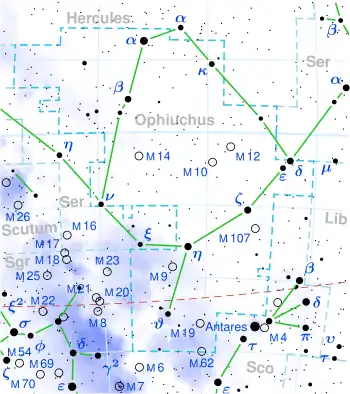 | |
| Observation data Epoch J2000 Equinox J2000 | |
|---|---|
| Constellation | Ophiuchus |
| Right ascension | 16h 32m 08.19983s[1] |
| Declination | −21° 27′ 59.0120″[1] |
| Apparent magnitude (V) | 4.45[2] (4.44 – 4.51)[3] |
| Characteristics | |
| Evolutionary stage | main sequence[4] |
| Spectral type | ApSrEuCr[5] or A2 Vp(SrCrEu st, K sn)[4] |
| U−B color index | +0.13[6] |
| B−V color index | +0.130±0.002[2] |
| Variable type | α2 CVn[3] |
| Astrometry | |
| Radial velocity (Rv) | +2.5±0.7[7] km/s |
| Proper motion (μ) | RA: +21.12[1] mas/yr Dec.: +35.26[1] mas/yr |
| Parallax (π) | 19.34 ± 0.21 mas[1] |
| Distance | 169 ± 2 ly (51.7 ± 0.6 pc) |
| Absolute magnitude (MV) | 0.88[2] |
| Details[8] | |
| Mass | 2.25+0.13 −0.35 M☉ |
| Radius | 2.97±0.19 R☉ |
| Luminosity | 34.7±1.6 L☉ |
| Surface gravity (log g) | 3.85+0.65 −0.69 cgs |
| Temperature | 8,150±250 K |
| Metallicity [Fe/H] | −0.47[9] dex |
| Rotation | 2.3205±0.0002[10] |
| Rotational velocity (v sin i) | 32.2±1.4 km/s |
| Age | 860+150 −110 Myr |
| Other designations | |
| Database references | |
| SIMBAD | data |
Omega Ophiuchi, which is Latinized from ω Ophiuchi, is a single,[12] variable star in the equatorial constellation of Ophiuchus, located just to the north of the ecliptic near the western constellation border with Scorpius. It is a white-hued star that is faintly visible to the naked eye with an apparent visual magnitude that fluctuates around 4.45.[2] Parallax measurements indicate it lies at a distance of about 168.6 light years from the Sun.[1] It is drifting further away with a radial velocity of +2.5 km/s.[7]
This object is an Ap star with a stellar classification of ApSrEuCr,[5] displaying strong abundance anomalies of the elements strontium, europium, and chromium. Abt and Morrell (1995) found a class of A2 Vp(SrCrEu st, K sn),[4] showing further an A-type main-sequence star with a Ca II line (single-ionized calcium) having both sharp and broad components. It is an Alpha2 Canum Venaticorum variable, with its brightness ranging from magnitude 4.44 down to 4.51 over a period of 2.99 days.[3] A strong magnetic field has been measured on the surface.[10]
Omega Ophiuchi is around 860 million years old with a projected rotational velocity of 32.2 km/s[8] and a rotation period of 2.3 days.[10] It has 2.3 times the mass of the Sun and 3.0 times the Sun's radius. The star is radiating 35 times the luminosity of the Sun from its photosphere at an effective temperature of 8,150 K.[8] It is a source of X-ray emission.[13]
References
- 1 2 3 4 5 6 Van Leeuwen, F. (2007). "Validation of the new Hipparcos reduction". Astronomy and Astrophysics. 474 (2): 653–664. arXiv:0708.1752. Bibcode:2007A&A...474..653V. doi:10.1051/0004-6361:20078357. S2CID 18759600. Vizier catalog entry
- 1 2 3 4 Anderson, E.; Francis, Ch. (2012). "XHIP: An extended hipparcos compilation". Astronomy Letters. 38 (5): 331. arXiv:1108.4971. Bibcode:2012AstL...38..331A. doi:10.1134/S1063773712050015. S2CID 119257644. Vizier catalog entry
- 1 2 3 Samus, N. N.; et al. (2017). "General Catalogue of Variable Stars". Astronomy Reports. 5.1. 61 (1): 80–88. Bibcode:2017ARep...61...80S. doi:10.1134/S1063772917010085. S2CID 125853869.
- 1 2 3 Abt, Helmut A.; Morrell, Nidia I. (1995). "The Relation between Rotational Velocities and Spectral Peculiarities among A-Type Stars". Astrophysical Journal Supplement. 99: 135. Bibcode:1995ApJS...99..135A. doi:10.1086/192182.
- 1 2 Houk, Nancy; Smith-Moore, M. (1978). Michigan catalogue of two-dimensional spectral types for the HD stars. Vol. 4. Ann Arbor: Dept. of Astronomy, University of Michigan. Bibcode:1988mcts.book.....H.
- ↑ Ducati, J. R. (2002). "VizieR Online Data Catalog: Catalogue of Stellar Photometry in Johnson's 11-color system". CDS/ADC Collection of Electronic Catalogues. 2237. Bibcode:2002yCat.2237....0D.
- 1 2 Gontcharov, G. A. (2006). "Pulkovo Compilation of Radial Velocities for 35 495 Hipparcos stars in a common system". Astronomy Letters. 32 (11): 759–771. arXiv:1606.08053. Bibcode:2006AstL...32..759G. doi:10.1134/S1063773706110065. S2CID 119231169.
- 1 2 3 Sikora, J.; et al. (February 2019). "A volume-limited survey of mCP stars within 100 pc - I. Fundamental parameters and chemical abundances". Monthly Notices of the Royal Astronomical Society. 483 (2): 2300–2324. arXiv:1811.05633. Bibcode:2019MNRAS.483.2300S. doi:10.1093/mnras/sty3105. S2CID 119089236.
- ↑ Soubiran, Caroline; Le Campion, Jean-François; Brouillet, Nathalie; Chemin, Laurent (2016). "The PASTEL catalogue: 2016 version". Astronomy & Astrophysics. 591: A118. arXiv:1605.07384. Bibcode:2016A&A...591A.118S. doi:10.1051/0004-6361/201628497. S2CID 119258214.
- 1 2 3 Sikora, J.; et al. (March 2019). "A volume-limited survey of mCP stars within 100 pc II: rotational and magnetic properties". Monthly Notices of the Royal Astronomical Society. 483 (3): 3127–3145. arXiv:1811.05635. Bibcode:2019MNRAS.483.3127S. doi:10.1093/mnras/sty2895. S2CID 119415579.
- ↑ "ome Oph". SIMBAD. Centre de données astronomiques de Strasbourg. Retrieved 2019-10-28.
- ↑ Eggleton, P. P.; Tokovinin, A. A. (September 2008). "A catalogue of multiplicity among bright stellar systems". Monthly Notices of the Royal Astronomical Society. 389 (2): 869–879. arXiv:0806.2878. Bibcode:2008MNRAS.389..869E. doi:10.1111/j.1365-2966.2008.13596.x. S2CID 14878976.
- ↑ Schröder, C.; et al. (April 2008). "Magnetic fields in X-ray emitting A-type stars". Contributions of the Astronomical Observatory Skalnaté Pleso. 38 (2): 447–448. arXiv:0712.0173. Bibcode:2008CoSka..38..447S.